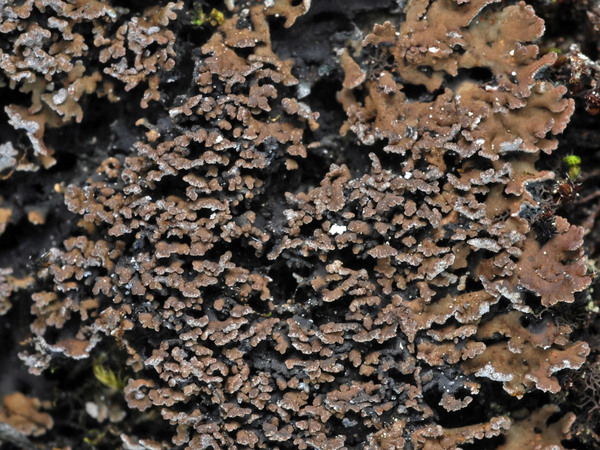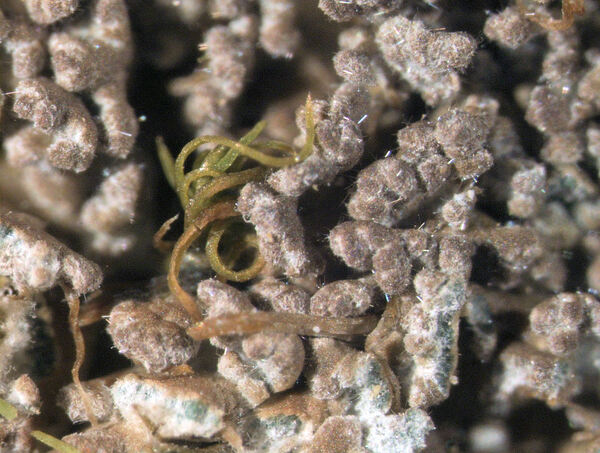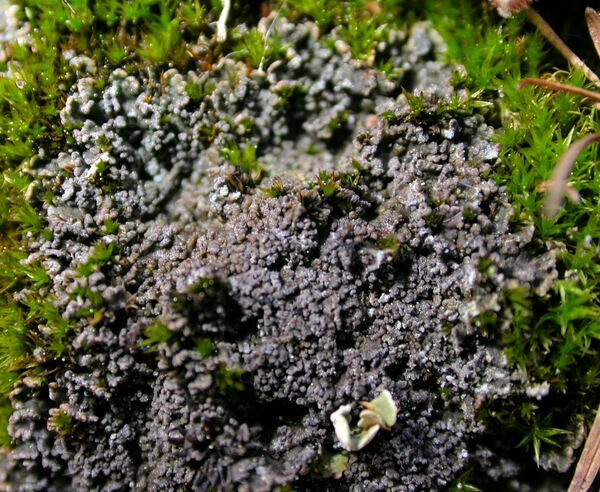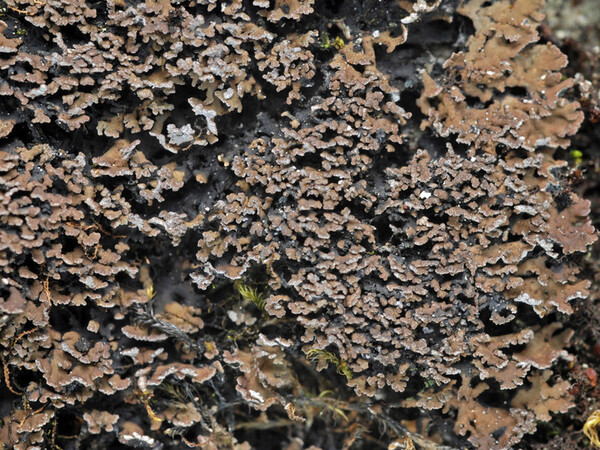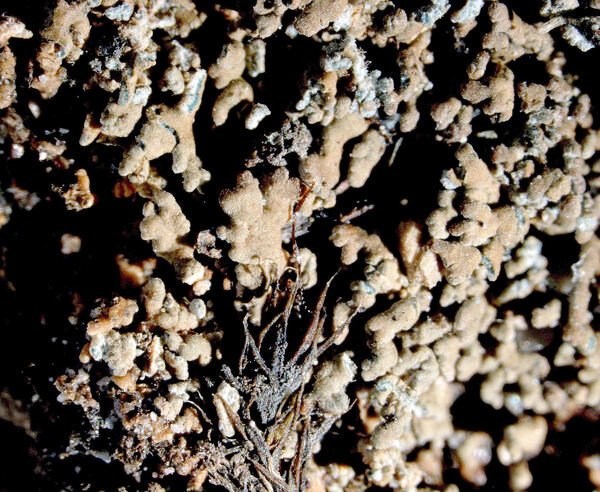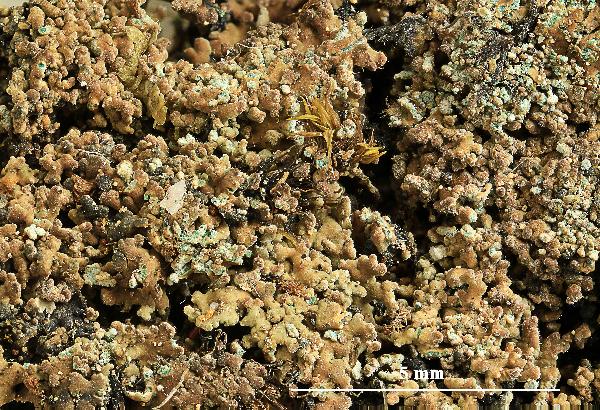Fuscopannaria praetermissa (Nyl.) P.M. Jørg.
J. Hattori Bot. Lab., 76: 205, 1994. Basionym: Pannaria praetermissa Nyl. in Chydenius & Furuhjelm - Not. Sällsk. Fauna Fl. Fenn. Förh., 4: 97, 1858.
Synonyms: Lecidea carnosa var. lepidiota Sommerf.; Massalongia carnosa var. lepidiota (Sommerf.) Körb.; Pannaria lepidiota (Sommerf.) Th. Fr.; Pannaria lepidiota f. sorediosa Vain.; Pannaria lepidiota var. imbricata Vain.; Pannaria lepidiota var. tristis Th. Fr.; Parmeliella lepidiota (Sommerf.) Vain.; Parmeliella praetermissa (Nyl.) P. James; Toninia coeruleonigricans (Lightf.) Th. Fr. non auct.; Trachyderma praetermissum (Nyl.) Trevis.
Distribution: N - Frl (Tretiach & Hafellner 2000), Ven (Nascimbene & Caniglia 2003c, Nascimbene 2005c, 2008c, Nascimbene & Marini 2007), TAA (Nascimbene & al. 2006, 2022, Thor & Nascimbene 2007, Nascimbene 2008b), Lomb (Etayo & Navarro-Rosinés 2008), Piem (Isocrono & al. 2004), VA (Nascimbene & al. 2021), Lig (TSB 33471). C - Tosc (Nascimbene & al. 2021), Abr (Vallese & al. 2022).
Description: Thallus squamulose, heteromerous, 0.2-0.4 mm thick, brown to dark brown with a bluish tinge, forming continuous, several cm wide, thick crusts, usually without hypothallus. Squamules 2(-3) mm long, up to c. 1.5 mm broad, round to weakly elongate, incised, flattened, contiguous or mostly imbricate, the margins white-felted due to accumulation of terpenoid crystals, with erect, finger-like lobules looking like isidia, the apex of the lobes and also the lobules often breaking off, revealing the photobiont layer. Upper cortex sclerenchymatous, (20-)30-50 µm thick; lower surface ecorticate, felted. Apothecia rare, cryptolecanorine, to 1.5 mm across, with a brown, usually convex disc, a dark proper margin, and an often excluded, granulose thalline margin. Proper exciple subparaplectenchymatous, 60-80 µm wide; epithecium pale brown; hymenium colourless, 100-120 µm high, hemiamyloid, I+ blue-green rapidly turning red-brown; paraphyses simple, the apical cells slightly swollen; hypothecium colourless. Asci 8-spored, subcylindrical to clavate, with a I+ blue tholus and an internal, more intensely I+ blue apical plug. Ascospores 1-celled, hyaline, ovoid to broadly ellipsoid, often with a single, large oil droplet, 18-22 x 9-11 µm, with a thick, smooth epispore. Photobiont cyanobacterial (Nostoc, the cells in clusters). Pycnidia wart-like. Conidia bacilliform. Spot tests: Thallus K-, C-, KC-, P-, UV-. Chemistry: unidentified aliphatic acids and triterpenoids.Note: an arctic-alpine to boreal-montane, circumpolar lichen found on calciferous soil, mosses and plant debris, with optimum near and above treeline.
Growth form: Squamulose
Substrata: soil, terricolous mosses, and plant debris
Photobiont: cyanobacteria, filamentous (e.g. Nostoc, Scytonema)
Reproductive strategy: mainly asexual, by isidia, or isidia-like structures (e.g. schizidia)
Commonnes-rarity: (info)
Alpine belt: rare
Subalpine belt: rather rare
Oromediterranean belt: absent
Montane belt: very rare
Submediterranean belt: absent
Padanian area: absent
Humid submediterranean belt: absent
Humid mediterranean belt: absent
Dry mediterranean belt: absent
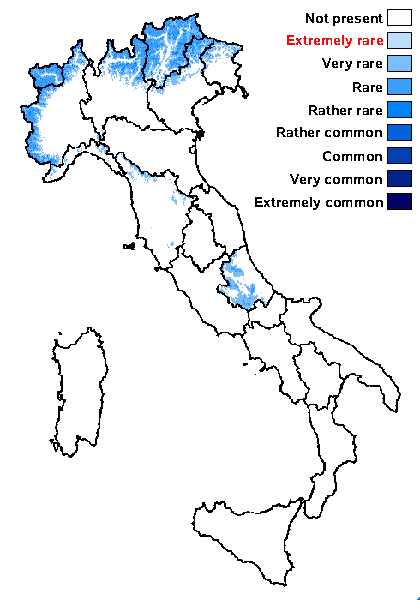
Predictive model
Herbarium samples
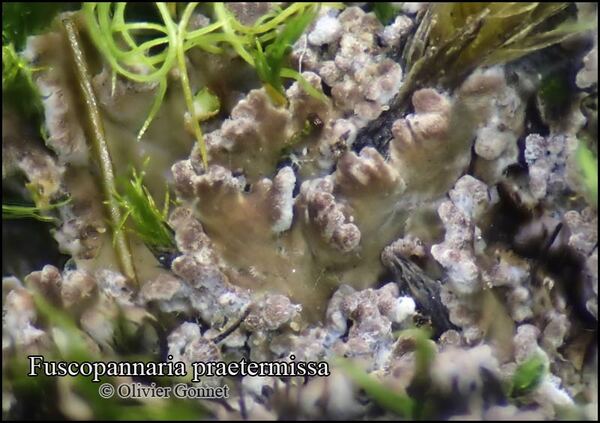
Courtesy Danièle et Olivier Gonnet - Source: https://www.afl-lichenologie.fr/Photos_AFL/Photos_AFL_F/Texte_F_1/Fuscopannaria_praetermissa.htm
France, septembre 2014 - Mont Cenis - Parc de la Vanoise - Savoie
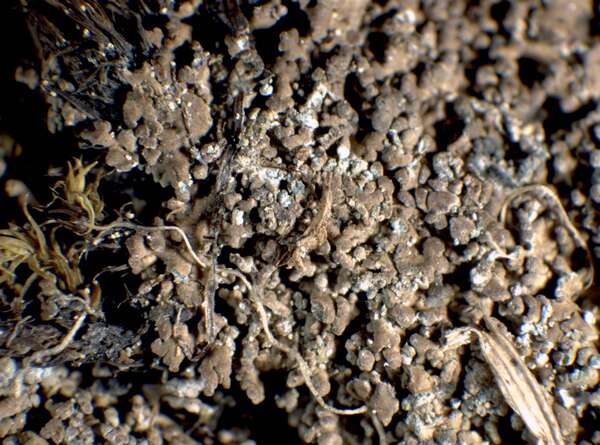

P.L. Nimis; Owner: Department of Life Sciences, University of Trieste
Herbarium: TSB (11526)
2001/11/28
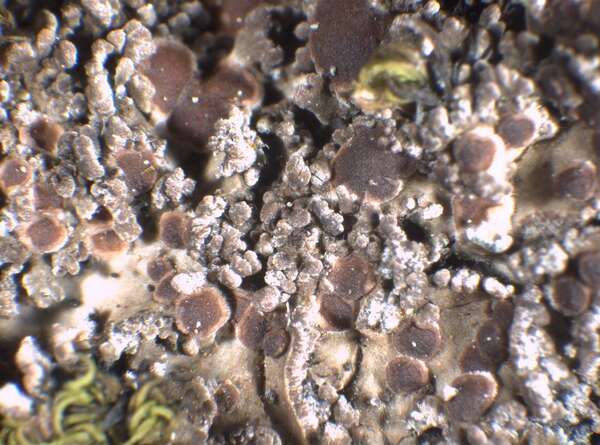

P.L. Nimis; Owner: Department of Life Sciences, University of Trieste
Herbarium: Herb. J.Nascimbene (11526)
2003/03/31
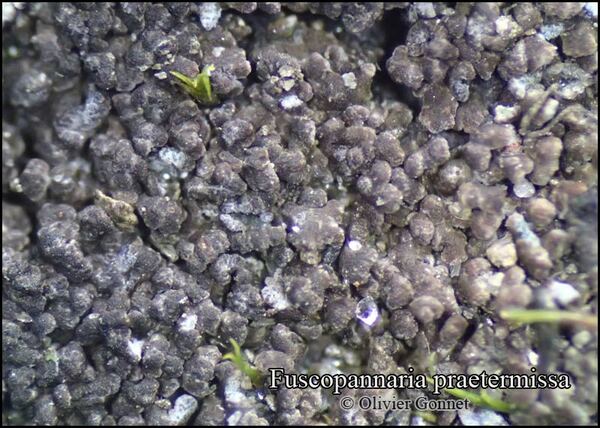
Courtesy Danièle et Olivier Gonnet - Source: https://www.afl-lichenologie.fr/Photos_AFL/Photos_AFL_F/Texte_F_1/Fuscopannaria_praetermissa.htm
France, septembre 2014 - Mont Cenis - Parc de la Vanoise - Savoie
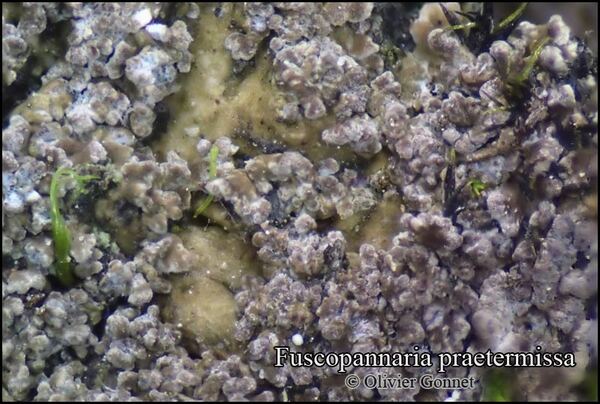
Courtesy Danièle et Olivier Gonnet - Source: https://www.afl-lichenologie.fr/Photos_AFL/Photos_AFL_F/Texte_F_1/Fuscopannaria_praetermissa.htm
France, septembre 2014 - Mont Cenis - Parc de la Vanoise - Savoie
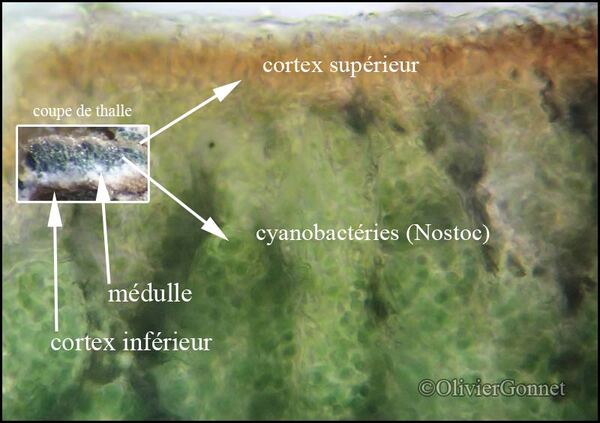
Courtesy Danièle et Olivier Gonnet - Source: https://www.afl-lichenologie.fr/Photos_AFL/Photos_AFL_F/Texte_F_1/Fuscopannaria_praetermissa.htm
France, septembre 2014 - Mont Cenis - Parc de la Vanoise - Savoie
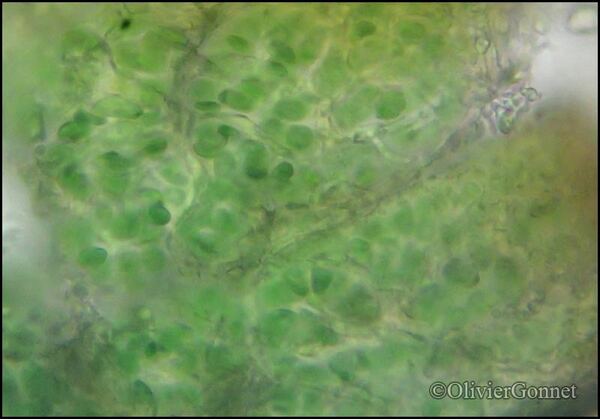
Courtesy Danièle et Olivier Gonnet - Source: https://www.afl-lichenologie.fr/Photos_AFL/Photos_AFL_F/Texte_F_1/Fuscopannaria_praetermissa.htm
France, septembre 2014 - Mont Cenis - Parc de la Vanoise - Savoie
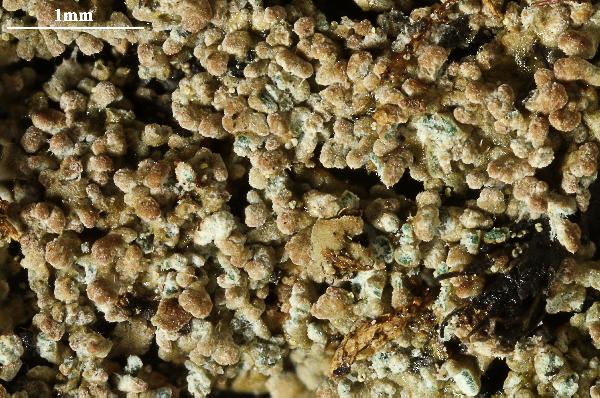

Felix Schumm - CC BY-SA 4.0
[20920], Austria, Oberösterreich, Eastern Alps, Totes Gebirge, 5.4 km
NNE of Liezen, Hochangern, near a striking deep hollow between
Torkoppen and Lärchkogel, 47°36'55'' N, 14°15'10'' E, on earth. Leg.J.
Hafellner (no 78768) & L. Muggia, 10.8.2010. det. J. Hafellner. DUPLA
GRAECENSIA LICHENUM NR. 1130.
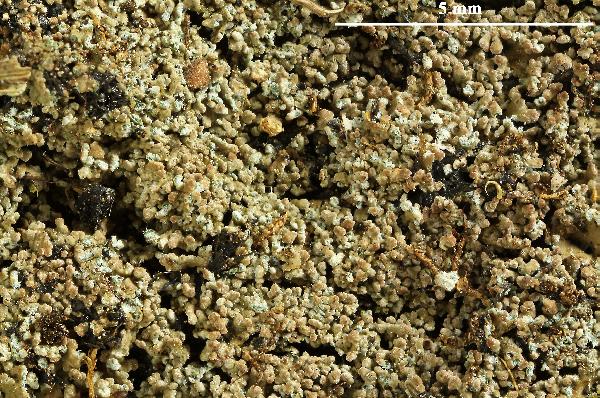

Felix Schumm - CC BY-SA 4.0
[20920], Austria, Oberösterreich, Eastern Alps, Totes Gebirge, 5.4 km
NNE of Liezen, Hochangern, near a striking deep hollow between
Torkoppen and Lärchkogel, 47°36'55'' N, 14°15'10'' E, on earth. Leg.J.
Hafellner (no 78768) & L. Muggia, 10.8.2010. det. J. Hafellner. DUPLA
GRAECENSIA LICHENUM NR. 1130.
Growth form: Squamulose
Substrata: soil, terricolous mosses, and plant debris
Photobiont: cyanobacteria, filamentous (e.g. Nostoc, Scytonema)
Reproductive strategy: mainly asexual, by isidia, or isidia-like structures (e.g. schizidia)
Commonnes-rarity: (info)
Alpine belt: rare
Subalpine belt: rather rare
Oromediterranean belt: absent
Montane belt: very rare
Submediterranean belt: absent
Padanian area: absent
Humid submediterranean belt: absent
Humid mediterranean belt: absent
Dry mediterranean belt: absent

Predictive model
| Herbarium samples |

Courtesy Danièle et Olivier Gonnet - Source: https://www.afl-lichenologie.fr/Photos_AFL/Photos_AFL_F/Texte_F_1/Fuscopannaria_praetermissa.htm
France, septembre 2014 - Mont Cenis - Parc de la Vanoise - Savoie


P.L. Nimis; Owner: Department of Life Sciences, University of Trieste
Herbarium: TSB (11526)
2001/11/28


P.L. Nimis; Owner: Department of Life Sciences, University of Trieste
Herbarium: Herb. J.Nascimbene (11526)
2003/03/31

Courtesy Danièle et Olivier Gonnet - Source: https://www.afl-lichenologie.fr/Photos_AFL/Photos_AFL_F/Texte_F_1/Fuscopannaria_praetermissa.htm
France, septembre 2014 - Mont Cenis - Parc de la Vanoise - Savoie

Courtesy Danièle et Olivier Gonnet - Source: https://www.afl-lichenologie.fr/Photos_AFL/Photos_AFL_F/Texte_F_1/Fuscopannaria_praetermissa.htm
France, septembre 2014 - Mont Cenis - Parc de la Vanoise - Savoie

Courtesy Danièle et Olivier Gonnet - Source: https://www.afl-lichenologie.fr/Photos_AFL/Photos_AFL_F/Texte_F_1/Fuscopannaria_praetermissa.htm
France, septembre 2014 - Mont Cenis - Parc de la Vanoise - Savoie

Courtesy Danièle et Olivier Gonnet - Source: https://www.afl-lichenologie.fr/Photos_AFL/Photos_AFL_F/Texte_F_1/Fuscopannaria_praetermissa.htm
France, septembre 2014 - Mont Cenis - Parc de la Vanoise - Savoie


Felix Schumm - CC BY-SA 4.0
[20920], Austria, Oberösterreich, Eastern Alps, Totes Gebirge, 5.4 km NNE of Liezen, Hochangern, near a striking deep hollow between Torkoppen and Lärchkogel, 47°36'55'' N, 14°15'10'' E, on earth. Leg.J. Hafellner (no 78768) & L. Muggia, 10.8.2010. det. J. Hafellner. DUPLA GRAECENSIA LICHENUM NR. 1130.


 INDEX FUNGORUM
INDEX FUNGORUM
 GBIF
GBIF
 DOLICHENS
DOLICHENS
